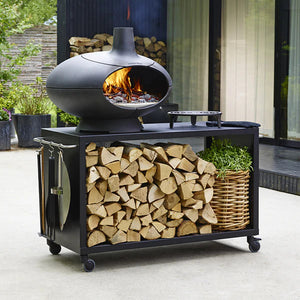How To Clean Your Stove

If you own a wood-burning or multi-fuel stove, you will want to keep it well maintained. That's because cleaning and maintaining your stove can be absolutely vital to the effective performance of your stove, and its longevity. A stove that is not kept clean has the potential to create a messy environment in your room. However, maintaining cleanliness not only helps in preventing messiness but also enhances efficiency and prolongs the lifespan of the stove. This, in turn, can lead to long-term cost savings for you. In this blog, we nail down the reasons why it is important to clean your wood-burning stove, how you should clean it, and the tools you will need.
Why should I clean my stove?
Quite simply, if you do not periodically clean your wood-burning stove, you are not giving it the best conditions to perform to the best of its ability. Cleaning your wood-burning stove in the manner which we recommend prepares it for use, and ensures that it will function more efficiently for longer. We advise cleaning your wood-burning stove in the spring or summer months, meaning it will be ready for action when the temperature begins to drop in summer.
Stove DIY: How to clean a wood-burning stove
Empty ash drawer
You should ensure that you empty the ash drawer all through the year, before it becomes full. However, at the bottom of the stove be sure to leave a layer of ash, as this provides insulation which can make fire lighting easier.
Clean glass
Soot stains can easily occur when the wood which you burn is too moist. But fear not - they are also easy to remove. Use a damp cloth dipped in cold ash and get to work on the sooty glass. Specific cleaning agents which do the job will also be safe to use.
Replace gaskets when necessary
You should replace your gaskets when they show signs of wear, as this is necessary to avoid wild combustion. Keep an eye on the condition of the gaskets in the ashpan and door of your stove.
Change the linings in the combustion chamber
It is only natural that the linings in the combustion chamber of your stove will wear out over time. When the cracks become more than 1 cm wide, it is time to replace these tiles with new ones of the same size.
Outside and inside
Because the surface of a stove is typically treated with high temperature paint, it only requires a dusting with a cloth or vacuum, rather than the application of strong cleaning solutions. When it comes to internal elements such as the baffle plate and flue pipe, this should be done regularly, depending on how much the stove is used. You should always wait until the stove is completely cold before starting to clean.
Tool check
So which tools will you need for the cleaning and maintenance of your wooden stove? Here are some which we think will come in handy:
- Cloth and sponge - for the glass and exterior
- Vacuum cleaner - for the exterior (although a cloth will do)
- Heat resistant spray paint - to cover up any scratches
For any further advice or information, get in touch with our friendly team sales@stovesupermarket.co.uk
- Chris Murphy









